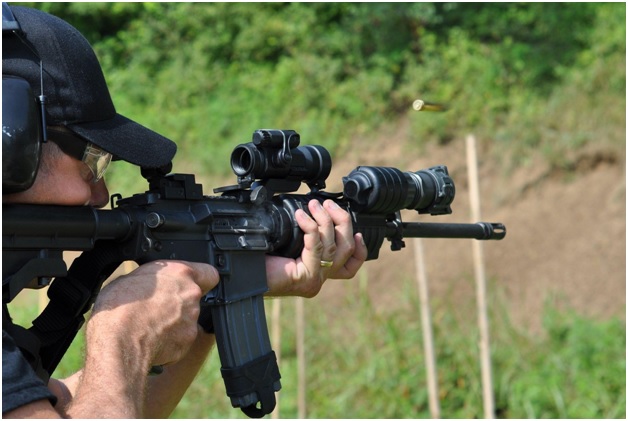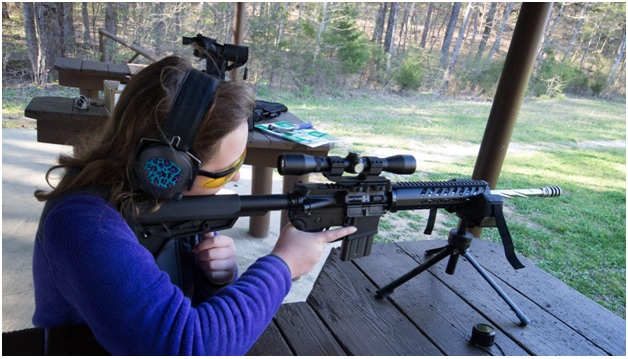One of the finer distinctions between the different gas systems and technology available for modern sporting rifles like AR-style platform is the one between direct impingement and gas pistons.
These two systems work in very similar ways, but despite their similarities are not quite the same. Each has its own nuances, advantages, and of course, drawbacks. If you’re going from the ground up, now is a great time to get more familiar with the different options available at your disposal, as well as which might be best for you - say, if you’re building a .300 Blackout AR, for instance.
How a Gas Impingement System Works
Both gas impingement and gas piston systems utilize expanding gas to cycle the action of the gun, but in the direct impingement system, this effect is much more direct - hence the name.
When you fire a cartridge, and the propellant deflagrates, that gas expands rapidly behind the bullet, propelling it forward.
Chamber pressure continues to rise as the bullet moves forward towards the muzzle. Once the bullet passes the gas block, some gets siphoned off through the gas tube.
Ths gas expands under pressure through the gas tube until it reaches the bolt carrier group’s gas key which acts as a sealant between the gas tube and the carrier. Then pressure builds against the key until such point that the gas forces the BCG to the rear, which action also extracts and ejects the spent cartridge.
After this action is performed, the bolt carrier group presses back against the buffer weights and springs which then return the action to battery.
Because the gas impingement system has been around for so long, there are numerous advantages to its use. One is that the design of these systems has been continuously refined for many years. This is not new technology. What works works, and it is fairly reliable.
Also, because the gas impingement system has a minimum of parts (and no moving parts, except the BCG which isn’t really a part of the gas system, technically) it is failure-resistant and fairly reliable. It’s also relatively low maintenance from a parts perspective.
Because it has minimal parts, a gas impingement system is also very lightweight. Because you can get different length gas tubes, they’re also very versatile for builds with different barrel lengths.

Another thing to consider is recoil. Because there is no reciprocating piston in a gas impingement system, overall reciprocating mass is lower and therefore recoil is lower, too. This makes gas impingement guns smoother-shooting and lower on recoil than piston-driven actions.
Something else to keep in mind is that gas impingement systems are fairly affordable, making them attractive to builders as well.
With all of this being said, it’s important to note that it isn’t all sunshine and roses with gas impingement systems and there are some drawbacks, too.
The main one probably has to do with wear and dirt. Due to the high pressures within the gas system, the gas port can erode over time, which will allow more fouling-heavy gas into the firearm’s internals. Even before that happens, gas impingement systems are inherently dirty and spray a lot of fouling into the action. Keeping them clean is harder than it is with gas piston guns, and if you don’t keep them clean, reliability will flag.
How a Gas Piston System Works
In a direct impingement system, the gas presses directly back on the gas key of the BCG. in a gas piston gun, there is an intermediary step.
That is, the piston itself. In a gas piston system, the operation is basically the same except that when gas expands and reaches the gas block, it pushes back on a piston (sometimes referred to as an operating rod) which is connected to the bolt carrier group.
The system is shorter in a gas piston system, and no gasses from the chamber/bore come in direct contact with the BCG in this configuration.
While it was stated that gas impingement is a reliable method of cycling an AR’s action, there are many advantages of building an AR with a .300 Blackout upper piston, if that’s the caliber you have selected.
One is that they are more reliable than gas impingement systems. Another is that a gas piston system is inherently cleaner. You will still need to clean the gas block and piston, but the bolt carrier group should stay cleaner for longer.
With these things covered, there are some drawbacks to gas piston systems. One is expense; these cost more to build than gas impingement systems, and another is weight, since you will be adding a piston/operating rod to the build.
If you’ve chosen a .300 Blackout upper piston, know also this: piston-fired models also produce more recoil, so with the .300 BLK, you’ll be getting more recoil from the round (as compared to .223/5.56) as well as from the piston.
Also, they are not quite as accurate as direct impingement systems, because the piston and rod can affect barrel harmonics - so that is one more thing to keep in mind if you are a long-distance or precision shooter.
Is One Better Than the Other?

Before you settle on one over the other, and before you buy a .300 Blackout upper receiver piston, know that there is no single best option.
If long-range, precision accuracy and low recoil are all that matter to you, go with direct impingement. Just be aware you will have to clean the system more frequently and more thoroughly.
If low-maintenance and reliability are more important, then get a gas-piston and build the upper around that.
It’s really about what your expectations for the new rifle are.
Getting Started with a .300 Blackout Upper Piston
Getting ready to start your build? If you’re going to go with a .300 Blackout upper piston and build the rifle around that, we have the rest of the parts you need, including lower parts kits, barrels, and complete build kits. All you need to do is decide what you want to build and we are here with the rest.

